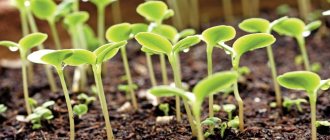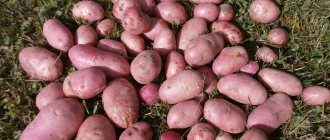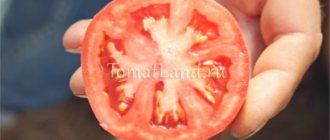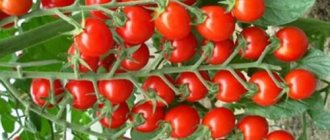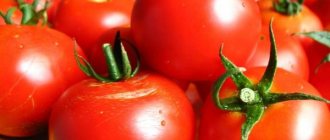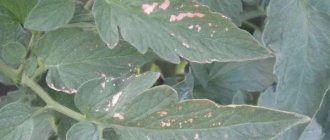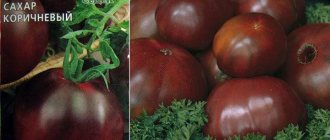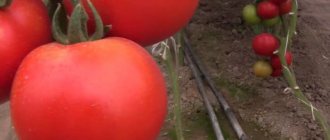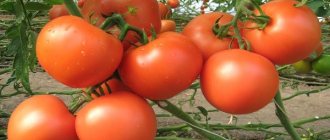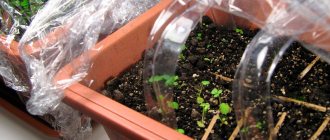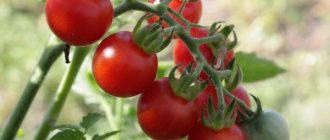Vegetable growing » Tomatoes
0
2121
Article rating
Kira Stoletova
Growing vegetables in the central part of the country and Siberia can sometimes be problematic. This is due to harsh climatic conditions and the inability to cultivate greens, cucumbers or tomatoes in open ground. But the golden rule of life says that those who do not want to decide something look for reasons, and those who want to change something look for opportunities. This is what happens with everyone’s favorite vegetables—tomatoes. There are varieties adapted to growing in unfavorable conditions, and one of them is the Tolstushka tomato.
Characteristics of tomato variety Tolstushka
Description of the variety
Fruit:
- Flat-round, medium-ribbed shape;
- With thick skin, bright red color;
- With fleshy, tender pulp;
- Medium size. The average weight varies from 250 to 320 grams.
Large-fruited tomatoes:
Bushes:
- Determinate, medium leafy plant;
- Reaches approximately 80 cm in height;
- The leaves are small in size, typical tomato shape, light green in color;
- The inflorescence is simple. The formation of the first inflorescence occurs above the 9th leaf.
Description and characteristics of the variety
Tomato Fatty "Gavrish" is a low-growing determinant whose shoots are distinguished by their laconic growth and compact size. What are the characteristics of bushes:
- height within 50-70 cm;
- medium foliage;
- tying 5-7 tomatoes on a hand at the same time;
- the number of fruitful clusters is 7-9.
Ripening begins in the mid-early period - 115-125 days from germination.
Tomato description and characteristics:
- average weight 200-250 g;
- the shape is round and flattened;
- the color is bright, glossy, scarlet-red;
- the pulp is tender, soft, fleshy;
- The skin is strong and does not crack.
The taste is classic, balances sourness and sweetness.
Tomato: advantages and disadvantages
The tomato variety “Tolstushka” has a number of undeniable advantages:
- Compactness;
- Good taste characteristics;
- No need for stepsoning;
- Immunity to diseases;
- Commercial appearance of the fruit;
- Possibility of transportation;
- Unpretentiousness in care.
The disadvantages include:
- The need for a greenhouse structure for cultivation;
- Unsuitability of tomatoes for whole-fruit canning.
Growing tomatoes
To get a bountiful harvest, tomatoes are cultivated through seedlings.
How to prepare seeds:
- The seed material is dipped into a salted aqueous solution. Seeds that float to the surface are discarded;
- High-quality seeds in a gauze bag are placed in a pale solution of potassium permanganate. After 30 minutes, the gauze with seeds is washed in clean water and left for three days on a saucer for germination.
The gauze must be periodically moistened with water.
Sowing seed material:
- Sowing seeds for seedlings is carried out at the end of March;
- Tomato seedlings require neutral soil with good drainage. Before sowing, prepare the soil. Mix peat, turf soil and sawdust in a ratio of 7:1:1.5. Humus or rotted manure is used as fertilizer. An alternative would be to purchase a ready-made substrate. It is convenient to sow seed material in peat pots, which contain a complex of useful substances;
- The containers are filled with moistened soil. Seed material is sown at intervals of 2 cm and sprinkled with a 1 cm layer of black soil. Containers should be covered with glass or polyethylene and placed in a warm, dark place;
- With the emergence of seedlings, the containers are moved to a lighted windowsill;
- Water the seedlings with settled water using a spray bottle. Water 1-2 times a week as the soil dries;
- After the formation of two permanent leaves, the seedlings are planted in a larger container. When sowing seed material in peat pots, picking is not carried out;
Before the procedure, the seedlings need watering, then they are carefully transferred to a new container along with a lump of earth.
- For three weeks before planting in a permanent place, the seedlings begin to harden. In the room where the seedlings are located, keep the window open for several hours, avoiding drafts. Then the containers are moved to a glassed-in balcony. Immediately before transplanting, the seedlings should be left outdoors for 24 hours.
Rules for planting seedlings:
- Planting in a greenhouse structure is carried out in May in completely heated soil;
- Seedlings ready for planting should have a height of 25 cm, a developed root system and 5-7 leaves;
- In the fall, wood ash and humus are added to the soil;
- In spring, the soil is thoroughly loosened and planting holes are formed at intervals of 40 cm, the row spacing is set at a distance of 50 cm. It is optimal to use a checkerboard pattern. This way the tomatoes will be provided with maximum lighting, and this will greatly facilitate further care of the plantings. It is recommended to plant no more than 4-5 seedlings per 1 m2;
- Tomato seedlings are transplanted together with a lump of earth. Sprinkle soil on the roots and compact it a little;
- Finally, the tomato bushes are watered abundantly.
Transplantation into open ground
This variety of tomatoes can grow both in greenhouses and in open ground. Preparing the bed for tomatoes should be done in the fall. It is better to choose an area where legumes, cabbage, radishes, turnips, and so on were previously grown. In the spring, you need to dig up this area, and only then sow it with early ripening vegetables.
Seedlings are planted around the end of May or early June. First you will have to completely remove all previous planting. The area is covered with fertilizer (20 grams of urea and granulated superphosphate, 10 grams of potassium sulfate). It is necessary to plant seedlings at small intervals of half a meter. As soon as about ten days have passed after transplanting the seedlings into open ground, at night or on cold days you will have to constantly cover the tomatoes with a special film.
It should be remembered that thick stems of seedlings may break if the plant is not tied along its entire length to a supporting device. Over time, the whole plant takes on the shape of a crumpet and is able to bear fruit profusely. It is the heavy fruits that can make the plant fragile.
Planting in a greenhouse can be done as early as early May. Following a basic care regimen will help you enjoy excellent yields. If the owner of the plot previously planted cucumbers on the ground, then this soil will need to be completely changed. The seedlings are planted on pre-prepared soil, which will include: sawdust, peat, sand, humus and fertilizers.
Tomatoes require constant ventilation, which will protect against many diseases to which different varieties of tomatoes are often exposed. In the first days after transplantation, you will have to water the bushes with warm water - in this case, abundant watering will not be required.
You can find out about the quality of the variety described above by studying the reviews of summer residents who actually grew the Tolstushka tomato and were satisfied with the result.
The first 10–12 days after planting, Tolstushka bushes need rest to adapt. They are not watered, fertilized or loosened, and protected from direct rays of the sun and strong winds. In the future, provide the usual care for low-growing varieties.
In the first weeks, until the roots have grown enough to reach the moist, deep layers of soil, the sprouts are watered abundantly, up to 5 liters for each plant. Water is used from collected rain or tap water, settled and heated to approximately the same temperature as the soil. Plants are watered at the root so as not to splash the leaves. Subsequently, watering is reduced to 3 liters 1–2 times a week, carried out whenever possible in the evening, when there is no direct sunlight.
Important! If tomato bushes are over-watered when they don’t need it, the fruits crack and grow watery, tasteless, with a low content of sugar and nutrients.
Feeding
Fertilizers are applied three times a season after abundant watering, alternating organic with mineral ones. You can also use the following mixtures:
- superphosphate - 20 g, water - 10 l;
- nitrophoska - 20 g, potassium humate - 20 g, water - 10 l;
- nitrophoska - 20 g, liquid mullein - 1 l, water - 10 l;
- superphosphate - 20 g, potassium sulfate - 10 g, chicken manure - 0.5 l, water - 10 l.
Good results are obtained by foliar feeding with a solution of 10 g of mineral mixture per 10 liters of water. A universal and environmentally friendly option is ash fertilizing with water infusion or incorporation into the soil in dry form, followed by watering.
Bush care
Plant care includes standard activities:
- Plantings need regular watering. At different stages of development, tomatoes need a certain amount of water. They pour water from barrels, where it warms and settles. After transplantation and before flowering begins, 5 liters of water are added to the root once a week, since young seedlings have a poorly developed root system for extracting moisture from the deep layers of the soil;
IMPORTANT: Curled and wilted tops indicate a moisture deficiency.
- Tomato bushes are fed with microelements and chemicals. The variety responds well to the addition of organic matter (bird droppings and a mixture of green herbs). The first time they fertilize until the ovary forms. The next feeding is carried out no earlier than 10 days after the first;
- It is also necessary to weed the rows and gently loosen the soil to avoid injury to the root system.
Pros of Tomato Fat
Today, due to unstable weather and climate change, gardeners who have always grown tomatoes and received a rich harvest want to find a tomato variety that could bear large quantities of fruit even despite cloudy days.
Tomato Fatty was bred by breeders. Crops from Dutch selection are distinguished by their hardiness, good immunity to diseases, high yields and unpretentiousness. The description of the Tolstushka tomato variety indicates that it was bred specifically for areas with a harsh climate. This is an ideal option for many gardeners.
The characteristics and description of the variety show that the tomato bushes are quite compact, and the flat-round fruits are very tasty. The weight of 1 tomato reaches a maximum of 320 g. The color is bright and red.
From 1 bush you can collect approximately 7 kg of fruit. These tomatoes have the name Fatty for a reason - the fruits are quite large. Because of this, they are not very suitable for conservation. Thanks to their bright and fresh taste, tomatoes are used in salads, sauces, juices, and lecho.
Tomatoes are quite shelf-stable and retain their presentation even during transportation.
From the moment the first sprouts appear until the peak of fruiting, approximately 3.5 months pass. The bushes are tall, growing up to 3 m, so tying is mandatory for them. Gardeners are pleased that the Tolstushka variety grows well and bears fruit both in open areas and in greenhouses.
The culture is so universal that even novice gardeners can cope with its cultivation. The plant does not need daily watering or frequent harvesting.
See also
Description of the Maryushka tomato, characteristics and cultivation of the variety
Read
Diseases and pests
Tomato variety “Fat” has average resistance to major diseases. “Fat girl” is rarely affected by fusarium and verticillium. If the rules of agricultural technology are violated, blossom end rot may occur. It is characterized by the appearance of dark spots on leaves and stems. Affected parts should be removed immediately. Then the plantings are treated with copper-containing preparations. Preventive actions:
- Compliance with the watering regime;
- Regular ventilation of the greenhouse or greenhouse structure;
- Cutting off excess tops;
- Once every 2-3 weeks, the plantings are treated with Fitosporin or other biological products.
